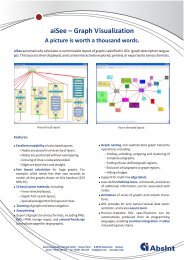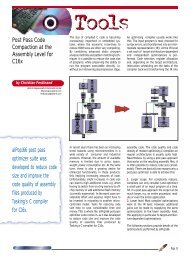Worst-Case Execution Time Prediction by Static Program ... - Absint
Worst-Case Execution Time Prediction by Static Program ... - Absint
Worst-Case Execution Time Prediction by Static Program ... - Absint
You also want an ePaper? Increase the reach of your titles
YUMPU automatically turns print PDFs into web optimized ePapers that Google loves.
Example: The library routine C_MEMCPY in TI’s standard library for the TMS470 consists of hand-written assembler<br />
code. It contains two computed branches whose targets can be specified as follows:<br />
instruction "C_MEMCPY" + 1 computed<br />
branches to pc + 0x04 <strong>by</strong>tes, pc + 0x14 <strong>by</strong>tes, pc + 0x24 <strong>by</strong>tes;<br />
instruction "C_MEMCPY" + 2 computed<br />
branches to pc + 0x10 <strong>by</strong>tes, pc + 0x20 <strong>by</strong>tes;<br />
The advantage of such relative specifications is that they work no matter what the absolute address of C_MEMCPY<br />
is.<br />
If the application contains an array P of function pointers, then a call P[i](x) may branch to any address<br />
contained in P. aiT tries to obtain the list of these addresses automatically: If the array access and the computed<br />
call in the executable are part of a small code pattern as it is typically generated <strong>by</strong> the compiler, aiT notices that<br />
the computed call is performed via this array. If furthermore the array contents are defined in a data segment so<br />
that they are statically available, and the array is situated in a ROM area so that its contents cannot be modified,<br />
then aiT automatically considers the addresses in the array as possible targets of the computed call.<br />
If array access and computed call are too far apart or realized in an untypical way, aiT cannot recognize that they<br />
belong together. Similar remarks apply to computed branches via switch tables. In both cases, the array or table<br />
belonging to the computed call or branch can be declared in the AIS file. The declaration starts like the ones<br />
described above:<br />
INSTRUCTION <strong>Program</strong>Point CALLS VIA ArrayDescriptor ;<br />
INSTRUCTION <strong>Program</strong>Point BRANCHES VIA ArrayDescriptor ;<br />
Here, the ArrayDescriptor describes the location and the format of the table that contains the call or branch<br />
targets. These targets are extracted from the table according to the given format rules.<br />
4.2 Loop Bounds<br />
WCET analysis requires that upper bounds for the iteration numbers of all loops be known. aiT tries to determine<br />
the number of loop iterations <strong>by</strong> loop bound analysis, but succeeds in doing so only for loops with constant bounds<br />
whose code matches certain patterns typically generated <strong>by</strong> the supported compilers. Bounds for the iteration<br />
numbers of the remaining loops must be provided <strong>by</strong> user annotations. A maximum iteration number of j is<br />
specified in the AIS parameter file as follows:<br />
LOOP <strong>Program</strong>Point Qualifier MAX j ;<br />
A <strong>Program</strong>Point is either an address or an expression of the form "R" + n LOOPS which means the nth<br />
loop in routine R counted from 1. Qualifier is an optional information:<br />
begin indicates that the loop test is at the beginning of the loop, as for C’s while-loops.<br />
end indicates that the loop test is at the end of the loop, as for C’s do-while-loops.<br />
If the qualifier is omitted, aiT assumes the worst case of the two possibilities, which is begin where the loop<br />
test is executed one more time. The begin/end information refers to the executable, not to the source code; the<br />
compiler may move the loop test from the beginning to the end, or vice versa.<br />
Example: loop "_prime" + 1 loop end max 10 ;<br />
specifies that the first loop in _prime has the loop test at the end and is executed at most 10 times.<br />
4.3 Source Code Annotations<br />
Specifications can also be included in C source code files as special comments marked <strong>by</strong> the key string ai:<br />
/* ai: specification1 ; ... specificationn ; */





